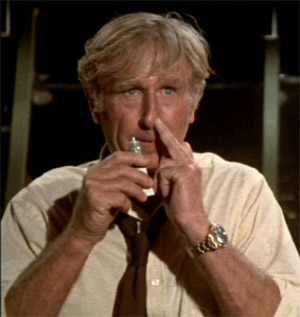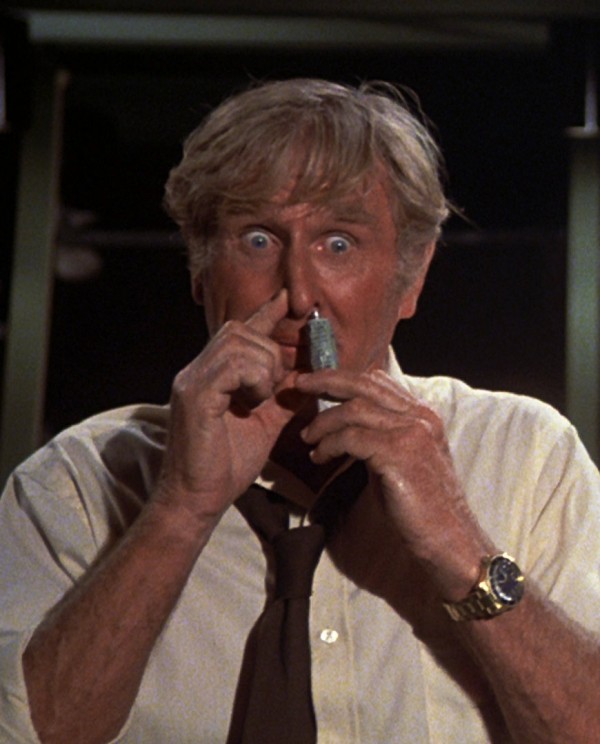Since August 2011, Peter Dunne has banned 30 synthetic cannabinoids by issuing Temporary Class Drug Notices. These are published in the New Zealand Gazette, “the official newspaper of the Government of New Zealand.” Here’s an example.
Pursuant to section 4C of the Misuse of Drugs Act 1975, I give notice that the following substances are classified as temporary class drugs:
CB-13
1-naphthalen-1-yl-(4-pentyloxynaphthalen-1-yl)methanone
MAM-2201
(1-(5-fluoropentyl)-1H-indol-3-yl)(4-methyl-1-naphthalenyl)-methanone
AKB48
N-(1-adamantyl)-1-pentyl-1H-indazole-3-carboxamide
XLR11
(1-(5-fluoropentyl)-1H-indol-3-yl)(2,2,3,3-tetramethylcyclopropyl)methanone
This notice will take effect on 13 July 2012 and will expire on 13 July 2013, unless cancelled or renewed as specified in section 4E of the Misuse of Drugs Act 1975.
Dated at Wellington this 2nd day of July 2012.
HON PETER DUNNE, Associate Minister of Health.
The legislation enabling the issuance of Temporary Class Drug Notices was the Misuse of Drugs Amendment Act (No 2) 2011, which became law on 9 August 2011. Let’s take a closer look at what it says.
4C Temporary class drug notice
(1) The Minister may, by notice in the Gazette, specify any substance, preparation, mixture, or article as a temporary class drug.
(2) The Minister must not give notice under subsection (1) if the substance, preparation, mixture, or article is a Class A controlled drug, a Class B controlled drug, a Class C controlled drug, a precursor substance, or a restricted substance (as defined in section 31 of the Misuse of Drugs Amendment Act 2005).
(3) The Minister must not give notice under subsection (1) unless he or she is satisfied that the substance, preparation, mixture, or article that is to be specified in the notice poses, or may pose, a risk of harm to individuals, or to society.
(4) A notice under subsection (1) may describe the substance, preparation, mixture, or article by any 1 or more of the following:
(a) its chemical name, or 1 of its chemical names:
(b) its product name:
(c) a description of the substance, preparation, mixture, or article, in the form that the Minister considers appropriate for the purposes of the notice.
(5) A notice under subsection (1) must state the date on which the notice comes into force.
(6) The date specified under subsection (5) must not be earlier than 7 days after the date of the publication of the notice in the Gazette.
4D Effect of temporary class drug notice
(1) Except as provided in this section, a temporary class drug is to be treated, while the temporary class drug notice remains in force, in the same way as if the drug were a controlled drug that is specified or described in Part 1 of Schedule 3.
(2) A temporary class drug specified or described in a temporary class drug notice is not to be added to any schedule of this Act while the notice is in force.
(3) Despite section 7(1), it is not an offence for a person, in relation to a temporary class drug, to do either or both of the following while the temporary class drug notice relating to that drug is in force:
(a) to possess for his or her own use less than 56 grams in total of any products (including cigarettes), or any drug forms (including flakes, tablets, or capsules), each containing some quantity of that temporary class drug:
(b) to use that temporary class drug.
(4) Possession by a person of 56 grams or more in total of any products (including cigarettes), or any drug forms (including flakes, tablets, or capsules), each containing some quantity of that temporary class drug is to be treated, for the purposes of this Act, as possession by that person of an amount, level, or quantity at and over which a controlled drug that is specified or described in Part 1 of Schedule 3 is presumed to be for supply.
(5) A substance that has a structure substantially similar to a temporary class drug is not to be treated as a controlled drug analogue by reason only of that similarity.
(6) While a temporary class drug notice is in force, the Minister must seek advice, as he or she considers appropriate, under section 5 or 5AA, or both, in relation to the temporary class drug and its appropriate classification, if any (including as a precursor substance, or as a restricted substance as defined in section 31 of the Misuse of Drugs Amendment Act 2005), under this Act.
(7) As soon as possible after the publication of a temporary class drug notice in the Gazette, and while a temporary class drug notice is in force, the Director-General of Health must ensure that the notice, and information about its effects, is available—
(a) on the Ministry of Health’s Internet site, in an electronic form that is publicly accessible; and
(b) in any other way that the Director-General considers appropriate in the circumstances.
(8) Despite the Regulations (Disallowance) Act 1989, a temporary class drug notice is not to be treated as a regulation for the purposes of the Acts and Regulations Publication Act 1989.
4E Duration of temporary class drug notice
(1) A temporary class drug notice expires at the earliest of—
(a) the close of the day that is 1 year after the date on which the notice came into force; or
(b) the date on which the substance, preparation, mixture, or article is—
(i) classified as a Class A controlled drug; or
(ii) classified as a Class B controlled drug; or
(iii) classified as a Class C controlled drug; or
(iv) added to Schedule 4 as a precursor substance; or
(v) classified as a restricted substance (as defined in section 31 of the Misuse of Drugs Amendment Act 2005); or
(c) its revocation by the Minister by notice in the Gazette.
(2) A temporary class drug notice may be renewed by the Minister—
(a) prior to the date of its expiry as calculated under subsection (1); and
(b) on 1 occasion only; and
(c) only for the purpose of allowing sufficient time for the Minister to obtain the advice that is to be sought under section 4D(6).
Did you pay special attention to the highlighted bits?
According to 4C(3), since August 2011 Peter Dunne has been satisfied 30 different times that a particular substance poses, or may pose, a risk of harm to individuals, or to society. Well, it’s nice to know that someone’s getting some satisfaction.
Now, according to 4D(6), “while a temporary class drug notice is in force, the Minister must seek advice, as he or she considers appropriate, under section 5 or 5AA, or both, in relation to the temporary class drug and its appropriate classification, if any (including as a precursor substance, or as a restricted substance as defined in section 31 of the Misuse of Drugs Amendment Act 2005), under this Act.” What advice did Peter Dunne consider it appropriate to seek, regarding the 30 substances he’s banned? He must have sought it. So what was it?
So far, Peter Dunne has renewed all his Temporary Class Drug Notices issued in 2011, prior to their expiry. Note that, according to 4E(2), this is only for the purpose of allowing sufficient time for the Minister to obtain the advice that is to be sought under section 4D(6). Peter Dunne must be seeking lots of advice. Otherwise, what’s taking him so long?
You know what I think? I don’t think Dunne’s been keeping his side of the deal at all. I’m going to ask him to find out.




You could have at least have scribbled a bone through his nose Richard!